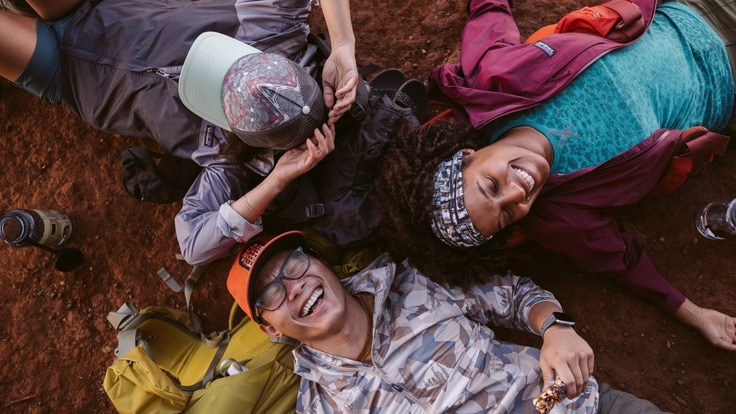Even if you're in decent shape, the first few days of a hiking trip or the first few hikes of the season can leave you feeling seriously sore and trail weary. While "recovery" for many might be a stop at the pub and a hot shower, the better approach involves steps you can take before you ever set foot on the trail.
We spoke with veteran Appalachian Trail (AT) hiker and Sales Manager Tim Bird at the REI store in Knoxville, Tennessee, to get his advice on how to recover after a hard day on the trail.
Here's an overview of some tried-and-true tips to prepare for and recover from a strenuous hike, with more detail below.
- Get gear that fits well, is broken in and helps prevent fatigue
- Eat and drink well, which includes planning your meals as carefully as your gear
- Plan reasonably (know your limits) and dial back miles when fatigue gets significant
- Slow your pace at the beginning (warm up) and at the end (cool down) of your hike
- Stretch, do yoga poses and/or self-massage muscles right away
Make Sure Your Hiking Gear Fits
Ill-fitting gear is the path to soreness and misery at the end of every hike. You'll be wearing your pack and boots for every mile of every trail, so getting the right fit and breaking in your boots (if needed) is critical. It's wise to go to a specialty store (like REI Co-op) for both a pack fitting and a boot fitting if you're upgrading or buying those items for the first time.
Planning to Get New Boots?
- Read How to Choose Hiking Boots.
- Also check out our guide to the best hiking boots.
- For tips on creating harmony between your feet and your new boots, read How to Break in Your Hiking Boots.
Haven't got your pack yet?
- For things to think about before you shop, read How to Choose a Backpack.
- Also take a look at our guide to the best backpacks.
Seriously Consider Trekking Poles
If you haven't tried trekking poles, you should—your knees and ankles will thank you. After all, why should your arms get a free ride while your legs do all the work? Using poles, especially on downhill sections, reduces the work that muscles supporting your knees and ankles must do. Poles also help you maintain your balance on dicey creek crossings or trail sections, which reduces the chance you might get injured. For tips on what to look for if you decide to buy a pair, read How to Choose and Use Trekking Poles to learn more.
Watch Overall Gear Weight
Studies of Appalachian Trail thru-hikers, not surprisingly, have shown a strong correlation between lowering pack weight and increasing average daily trail mileage. People with lower pack weights also had fewer injuries while hiking. At the very least, you want to keep pack weight to no more than 20 percent of your body weight. Read How Much Should Your Pack Weigh? and Ultralight Backpacking Basics to learn more about how to manage and lighten up your pack weight. If you want to start the process of switching to lighter gear, you can do so gradually, starting with one or more of the biggest items: your tent, pack, bag or pad.
Don't Skimp on Sleep Gear
On a multiday hike, getting a good night's sleep will dramatically affect how fresh or fatigued you feel on the next day's hike. So you need to balance your need for comfort with your need to save weight when you buy a sleeping bag and a sleeping pad. If you go too minimalist and end up feeling cold or inadequately supported, it can be hard to sleep well at night.
Also consider extras that help you sleep well. If a separate (small) pillow improves sleep quality, then it just might be worth the extra bulk and weight in your pack.
Make a Plan to Eat and Drink Well
It's amazing how many hikers obsess about the gear they carry, then just wing it when it comes to meals and snacks. Check out Meal Planning for Backpacking and How to Choose Energy Food and Drinks for guidance on putting together a trail menu. A smart strategy is to try out different meals and snacks on shakedown hikes and overnight trips, rather than finding out on a longer trek that the contents of your food bag are under-fueling your body and underwhelming your taste buds.
Though you'll certainly burn a lot of calories on the trail, resist the impulse to binge on candy bars. Complex carbohydrates and protein will power you better throughout the day. Read Eating Right on the Trail for thoughts about how to be more natural (and scientific) in your hiking food choices on the trail.
Drink and Snack Before You Get Thirsty and Hungry
Thirst and hunger are signals that your body has needs you aren't meeting. If you take frequent sips and bites throughout the day, your body won't experience fluid or calorie deficits and you'll be able to hike at peak efficiency. Having a pack with a reservoir and a hipbelt loaded with trail snacks allows you to refuel without breaking stride. And make sure you're fully hydrated and fed beginning a few days ahead of time so that your body has full reserves before your reach the trailhead.
Also snack and drink shortly after you reach camp, even if you're not feeling particularly hungry or thirsty yet. Having a high-protein meal for dinner later will also help replenish your body.
Plan Reasonably and Cut Back If Needed
A sure path to misery is an overly ambitious hiking plan. Be realistic about your abilities (limits) and avoid "destinationitis," where you obsess about reaching an objective. Pushing past the point of fatigue is a recipe for injury, or at the very least, will ensure a long and painful post-hike recovery. Look for trails that have multiple "aha" moments, rather than a long slog to a single spectacular place.
Warm Up and Cool Down
This is a technique borrowed from runners. When you begin your hike, go at an easy pace for the first few miles to allow your muscles to warm up. And, although it's tempting to gallop ahead as you get closer to the destination, slow your pace instead to allow your muscles to cool down gradually.
Stretch and Self-Massage Right Away
This is another tip borrowed from runners: Do a light stretching routine right after you finish hiking. If you have your own stretching routine, consider timing your stretches to be sure you don't rush through them. You can also check out Stretches for Trail Running for inspiration because trail runners and hikers rely on many of the same muscle groups.
If you know any yoga poses, doing a few of your favorites when you reach camp is another good way to stretch a little and ease your body into a more relaxed post-hike state. You can also check out some of the post-activity poses in Yoga for Trail Running for poses you might try.
Even though you're not likely to pack a foam roller in your pack, some of your gear can be pressed into duty as a rolling massager: A hard-sided water or fuel bottle, for example. For ideas on massages you might do, read Foam Roller Exercises. You can also use a collapsed trekking pole as an impromptu rolling stick on sore leg muscles.
Finally, avoid the temptation to simply collapse on the ground when you remove your pack. Even if you don't choose to do stretching, yoga or massage, simply doing a few light camp chores can be a good way to ease your body's transition from exertion to relaxation.

